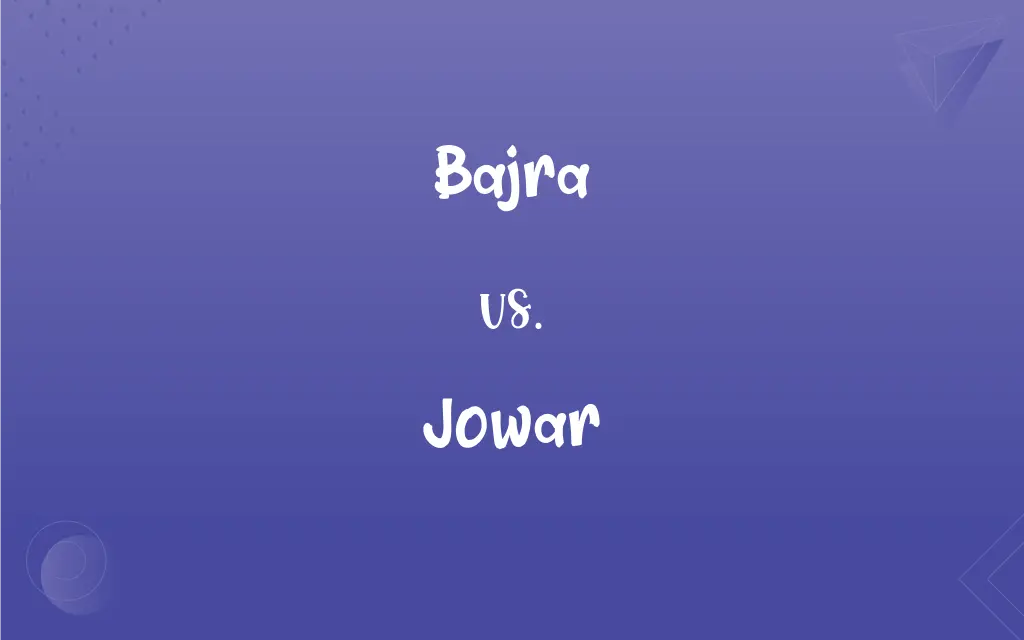Bajra vs. Jowar: What's the Difference?
Edited by Aimie Carlson || By Janet White || Published on February 4, 2024
Bajra (pearl millet) and jowar (sorghum) are both cereal grains; bajra has a nutty flavor and is used in drought-prone areas, while jowar is versatile and drought-resistant.

Key Differences
Bajra, also known as pearl millet, is a staple grain in many parts of India and Africa, known for its ability to thrive in harsh, arid conditions. Jowar, or sorghum, is similarly a hardy cereal grain, but it is more versatile in terms of the climates it can grow in, including temperate zones.
In terms of culinary use, bajra is often ground into flour and used in making flatbreads like roti. Its flavor is somewhat nutty and earthy. Jowar flour is also used for bread-making and has a milder, slightly sweet taste, making it a popular ingredient in gluten-free recipes.
Nutritionally, bajra is high in protein, fiber, and iron, making it an excellent choice for a nutritious diet. Jowar, on the other hand, is rich in antioxidants, B-vitamins, and dietary fiber, and is known for its cholesterol-lowering properties.
Bajra has a distinct, slightly bitter taste that might require an acquired palate, and its texture is generally denser in bread forms. Jowar is lighter and more adaptable to various culinary styles, from porridges to bread, and blends well with other flours.
Culturally, bajra is deeply rooted in the diets of rural and tribal populations in India, reflecting a traditional and sustainable lifestyle. Jowar, while also popular in India, has gained international recognition, especially in health-conscious and gluten-free circles.
ADVERTISEMENT
Comparison Chart
Climate Adaptability
Thrives in arid, dry regions
Grows in diverse climates, including temperate
Flavor Profile
Nutty and slightly bitter
Milder and slightly sweet
Nutritional Content
High in protein, fiber, iron
Rich in antioxidants, B-vitamins, fiber
Culinary Use
Mainly in flatbreads and porridges
Versatile - breads, porridges, mixed flours
Cultural Significance
Staple in rural India and parts of Africa
Widespread use, including in gluten-free diets
ADVERTISEMENT
Bajra and Jowar Definitions
Bajra
A cereal grain with a distinct nutty flavor.
Bajra flour adds a unique taste to gluten-free recipes.
Jowar
Rich in nutrients and often used as a wheat alternative.
For those allergic to wheat, jowar is an excellent substitute.
Bajra
Pearl millet, widely used in traditional Indian cooking.
She prepared a hearty bajra khichdi for dinner.
Jowar
A versatile grain known for its health benefits and adaptability.
Jowar is becoming popular in health-conscious diets.
Bajra
Cultivated mainly in dry areas due to its hardy nature.
Farmers in the desert often rely on bajra cultivation.
Jowar
A cereal crop that thrives in a variety of climates.
Jowar fields are common in both temperate and tropical regions.
Bajra
Used both as human food and animal fodder.
In our village, bajra serves as a feed for livestock.
Jowar
Sorghum, used in various culinary applications.
I use jowar flour to bake gluten-free bread.
Bajra
A grain known for its high nutrient content and drought resistance.
Bajra rotis are a staple in arid regions of India.
Jowar
A grain gaining global popularity for its versatility and nutrition.
Jowar salads are now a trend in urban health cafes.
Bajra
(India) pearl millet (Cenchrus americanus, syn. Pennisetum glaucum)
FAQs
What does bajra taste like?
Bajra has a nutty and slightly earthy flavor.
Is jowar easy to cook?
Yes, jowar is versatile and easy to cook.
Is jowar gluten-free?
Yes, jowar is naturally gluten-free.
Can bajra grow in wet climates?
Bajra prefers dry, arid conditions.
What is bajra?
Bajra is pearl millet, a cereal grain.
Is bajra good for health?
Yes, it's nutritious with high protein and fiber.
Does bajra contain gluten?
No, bajra is gluten-free.
Are bajra and jowar interchangeable in recipes?
They can be, but they have different flavors and textures.
Can jowar be eaten raw?
Jowar is usually cooked or used as flour.
Can bajra help in weight loss?
Yes, due to its high fiber content.
Is bajra suitable for diabetics?
Yes, its low glycemic index makes it suitable.
Can bajra be used in baking?
Yes, especially in gluten-free baking.
Is jowar a major crop in India?
Yes, it's widely grown and consumed in India.
Is bajra used in animal feed?
Yes, it's also common in animal feed.
What dishes can be made with jowar?
Jowar is used in bread, porridges, and gluten-free recipes.
How is jowar beneficial for health?
It's nutritious, with antioxidants and vitamins.
Are there different varieties of jowar?
Yes, there are several varieties, each suited to different climates.
Is jowar rich in fiber?
Yes, it's high in dietary fiber.
What is the origin of jowar?
Jowar, or sorghum, originated in Africa.
Does bajra require a lot of water to grow?
No, it's drought-resistant and requires minimal water.
About Author
Written by
Janet WhiteJanet White has been an esteemed writer and blogger for Difference Wiki. Holding a Master's degree in Science and Medical Journalism from the prestigious Boston University, she has consistently demonstrated her expertise and passion for her field. When she's not immersed in her work, Janet relishes her time exercising, delving into a good book, and cherishing moments with friends and family.
Edited by
Aimie CarlsonAimie Carlson, holding a master's degree in English literature, is a fervent English language enthusiast. She lends her writing talents to Difference Wiki, a prominent website that specializes in comparisons, offering readers insightful analyses that both captivate and inform.







































































